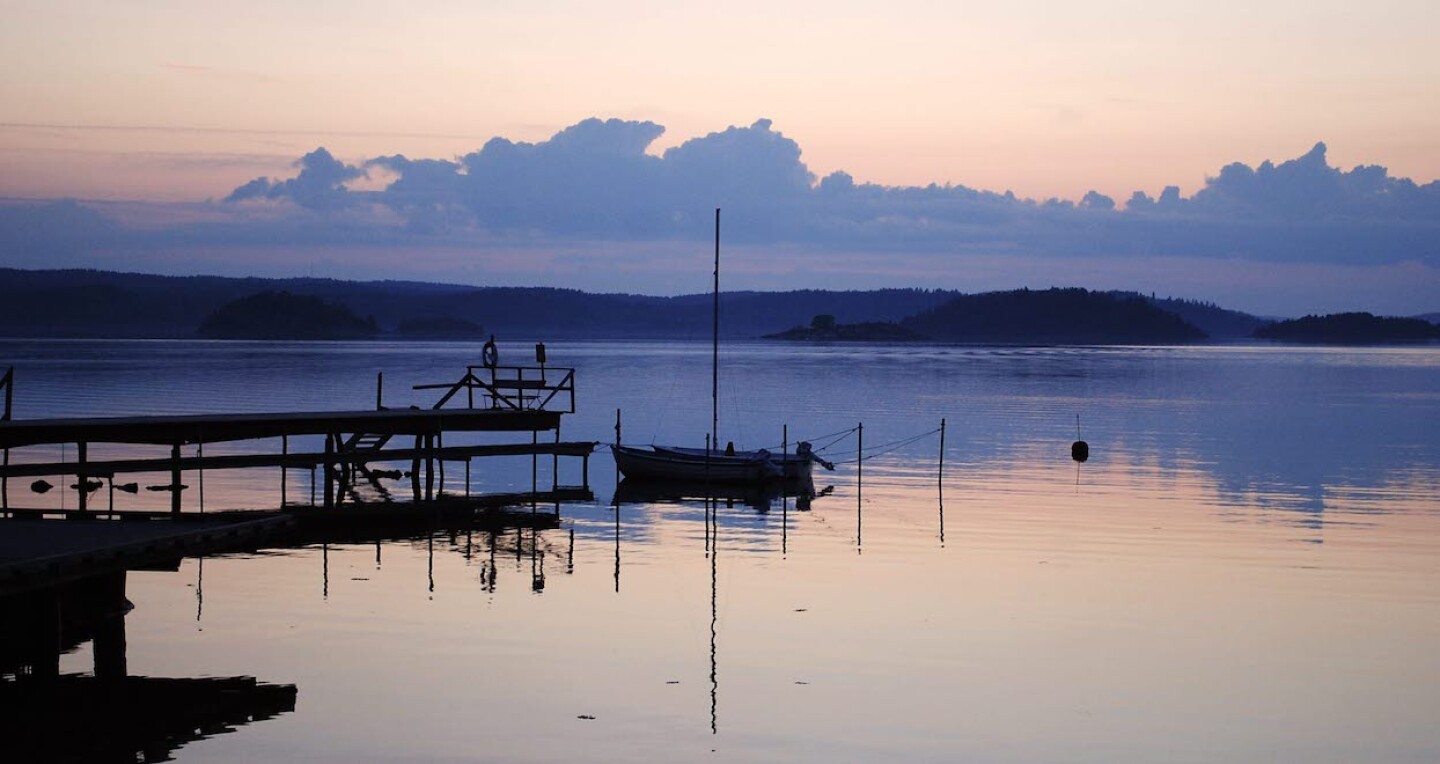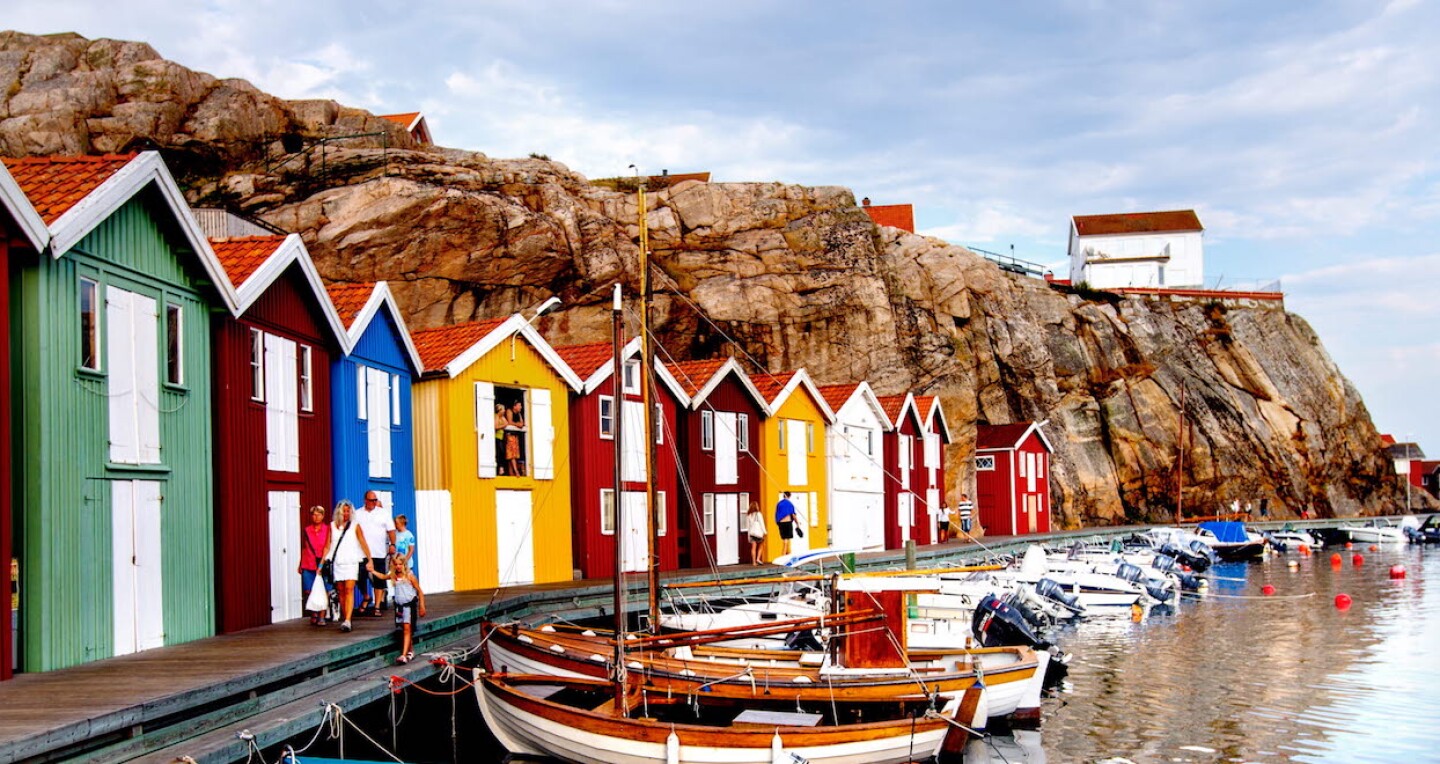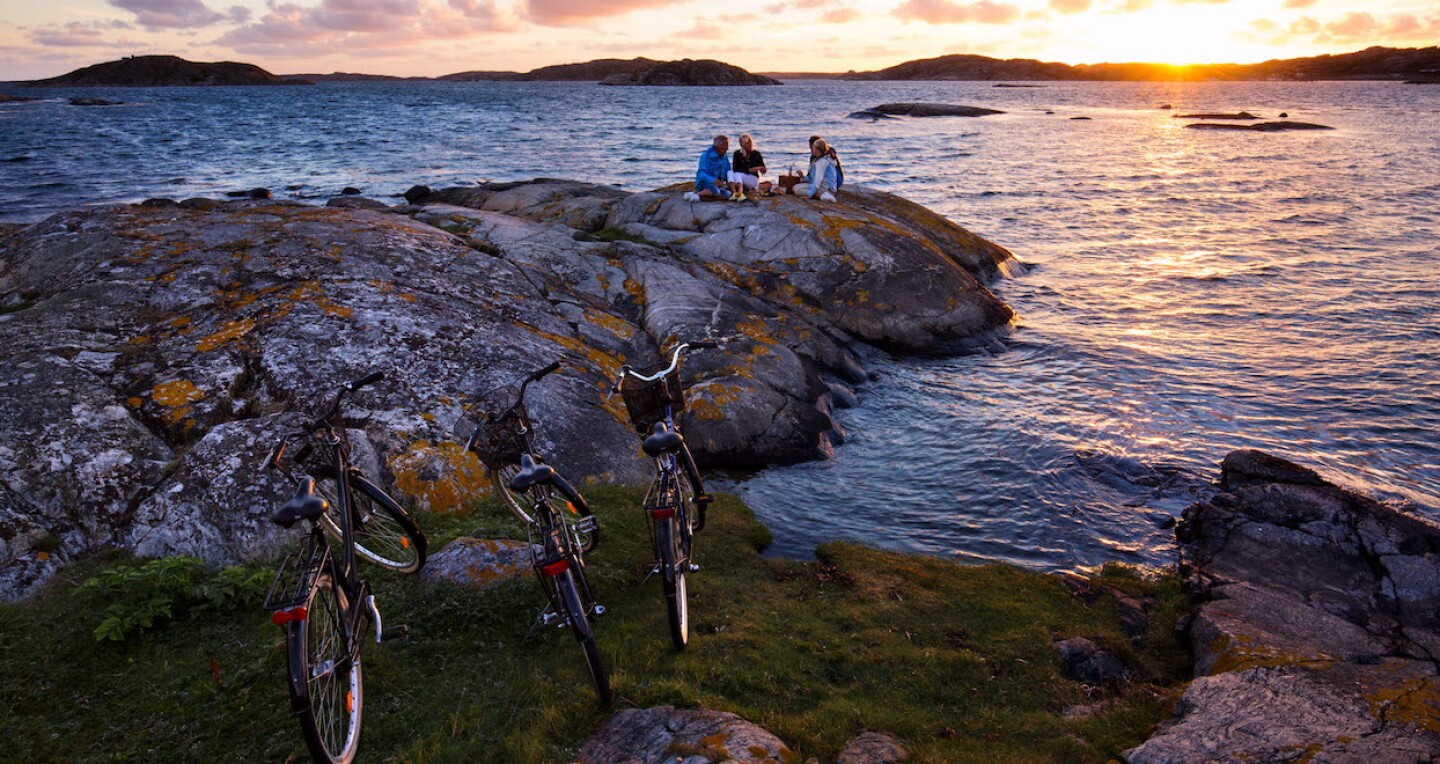If your ideal vacation includes days of hiking, mountain biking, and kayaking among beautiful landscapes of alpine peaks and forests, then Sweden is an obvious choice for your next trip. In fact, you wouldn’t even have to leave Stockholm to find waterways and lakes with crystal clear water: the capital city is home to the world’s first national urban park. This enormous, six-mile long arc of protected land is home to deer, hare, foxes, and a variety of birds that all thrive even within the city limits of Stockholm.
Beyond the capital, pristine wilderness can be found in every region of Sweden. This is a country that is physically larger than California, yet with a quarter of its population—open spaces abound. In 14 days, you’ll only get a small taste of its many varied landscapes. This itinerary includes some of the wildest parts (in the naturalist sense, that is) of Stockholm, its glittering archipelago of islands and the Lapland area above the Arctic Circle, as well as gorgeous Gothenburg and the surrounding area of West Sweden.
Itinerary / 14 DAYS
PLAN YOUR TRIP
PHOTO BY OLA ERICSON/IMAGEBANK.SWEDEN.SE
DAY 1Arrive in Stockholm
One option to consider is Ett Hem, located in a townhouse in the city’s Lärkstaden district. The name translates as “a home,” which is a fitting description, given the warm and welcoming atmosphere of this intimate, 12 rooms hotel. You may feel like you’re not at a hotel and instead visiting a Swedish friend who happens to have impeccable taste.
Then head out to see some of the city’s great outdoors. Built on 14 major islands, Stockholm has a setting that often feels more bucolic than urban. Many travelers head to Djurgården to visit the Vasa Museum on the western side of the island, but the island also forms the southern end of the Royal National City Park, which extends over 10.4 square miles (about eight times the size of New York City’s Central Park). Whether you want to explore on bike or foot, you’ll find trails running through woods and meadows, along tree-lined canals and isolated coves and bays.
The park isn’t only scenic, it’s also vital to preserving the city’s biodiversity. It includes 800 different flowering plants, 100 bird species, stands of ancient oaks, and even the occasional moose.
One of Stockholm’s other green spaces may be a surprise. Skogskyrkogården is a cemetery with a forest-like setting that was begun in 1917. Beneath its towering pines, you’ll find a number of chapels that are modernist masterpieces (by architects Gunnar Asplund and Sigurd Lewerentz). Those buildings and the innovative landscape design earned Skogskyrkogården a place on UNESCO’s list of World Heritage sites (it’s one of three in the Stockholm region). It’s a little south of the city center, just over 30 minutes by train from Gamla Stan.

PHOTO BY OLA ERICSON
DAY 2Stockholm’s Forests
Another option is to head to Hellasgården, an outdoors center located near the Nacka Nature Reserve that traces its roots back to the 19th century, when boys from Sodermalm were brought here to escape the pollution of the big city for a day. The air of Stockholm has improved dramatically in the last 100 years, but the center is still a popular country escape—especially since it takes only 15 minutes to get here. There are more than 20 activities to try: mountain biking, miniature golf, canoeing, standup paddleboarding, and more. This being Sweden, there’s also a sauna where you can sweat away any soreness at the end of your day of activities.

PHOTO BY HENRIK TRYGG
DAY 3Island Time
Whichever you choose to visit, though, you’re likely to find pristine beaches and hiking or biking trails. If your time is limited, Fjäderholmarna (a group of four islands) are among the ones closest to the city, just a 20-minute ferry ride away. Head to the beaches or explore some of the artists’ studios on Stora Fjäderholmen, the largest of the four islands; there’s even a brewery (Fjäderholmarnas) with its own brewpub. Before heading back to Stockholm, have lunch or dinner at Rökeriet, a restaurant overlooking the water. The smoked prawns and salmon are signature dishes, but you’ll also find other Swedish favorites: shrimp toasts, mussels, cheese boards, and pickled herring.
If you want to venture a little farther afield, the ferries to Vaxholm take about an hour. When you get to the island, you’ll find a lively scene of restaurants and stores, many located in restored historic houses painted in pastel hues. The island’s most famous site is actually on a separate island (though easily reached by ferry)—a fortress that has stood on small Vaxholmen Island since the 16th century. In addition to the fortifications, there’s a museum on the site.

PHOTO BY LOLA AKINMADE ÅKERSTRÖM
DAY 4Fly to Kiruna
Other activities also vary by season. In the winter, you can choose from snowmobiling, cross-country skiing, dogsledding, and other cold-weather options. In the summer, hiking, fishing, whitewater rafting, and visiting Sami villages are popular choices.
Some attractions are year-round ones: The Kiruna church, constructed from 1909–1912, is one of Sweden’s largest wooden buildings and also among the country’s most beautiful churches. Your hotel is open year-round as well, even though it’s the Icehotel. Yes, it is cold inside (and you’ll be provided with a coat when you stay there) but what guests most remember are the elaborate carved sculptures that make the hotel an enormous work of art. Each year, different artists are chosen to carve the ephemeral building, and the fantastic and magical interiors change each season.

PHOTO BY STAFFAN WIDSTRAND
DAYS 5 TO 8Abisko National Park
As with Kiruna, what you’ll do when you stay at Niehku depends on the season. From March to the end of May, most travelers come to take advantage of the world-class heli-skiing on the roughly 60 peaks in the area, including Sweden’s tallest—Kebnekaise—with an altitude of 6,909 feet. On daily outings, groups of four or five skiers attempt to make eight to 12 runs, with vertical drops of up to 4,500 feet (though between 1,600 and 2,900 is more typical). The chance to ski under the midnight sun is an appealing reason to visit for skiers looking for bragging rights.
Later in the season, heli-hiking, mountain biking, hunting for grouse, and fishing for char are all on the menu of activities offered by Niehku.
Other options in the area including visiting the Aurora Sky Station, which opened in 2007 in Abisko National Park. The mountaintop facility is a comfortable, heated, and stylish place to wait for the northern lights to begin their display. The chairlift to the station also operates in summer, for hikers who want to wander the surrounding peak while taking in the views and admiring the summer wildflowers in bloom.
On another day, you may want to visit the Sami village of Rávttas, closer to Kiruna, where you can meet some reindeer and then taste some smoked reindeer meat. You’ll learn about the Sami way of life and how the people have preserved it and their culture into the 21st century.

PHOTO BY HANNA SÖDERLUND/WESTSWEDEN.COM
DAY 9A Night of Glamping
You’ll arrive in Gothenburg late in the day; pick up a rental car and drive to Anfasteröd Gårdsvik in Ljungskile. This corner of Sweden’s west coast is known for its sheltered location—on the water but behind the island of Orust—which helps moderate the climate and provides some protection from the weather. It’s an idyllic place to go camping or, in your case, glamping. This experience, under a canopy of beech trees, includes sleeping in a safari tent with its own bathroom and kitchenette. The property’s cottages are equally tempting. Some date from as early as the 1800s but have been thoroughly updated with modern amenities.
It’s been a relatively long day of travel, so enjoy an early evening dinner on the property. You’ll sit at a table overlooking the sea while chefs grill up a meal of fresh fish paired with vegetables from nearby farms. Then turn in and rely on the sound of birdsong to be your alarm clock in the morning.

PHOTO BY ÅSA DAHLGREN/WESTSWEDEN.COM
DAY 10Ramsvikslandet
After breakfast, drive to Ramsvikslandet, about an hour to the north. By now, you’ve likely picked up enough Swedish to figure out from its name that Ramsvikslandet is an island, though it’s connected to the mainland by a small bridge. This is a rugged stretch of coast, with pink granite rocks overlooking the sea, and it makes for gorgeous hiking. Paths run along the water for the entire length of the island, while others crisscross its interior.
Then drive about 15 minutes south to another island, Smögen. Here you can have lunch at Skärets Café, which has been serving its open-faced prawn sandwiches since the 1930s. Its location on the Smögen Boardwalk with harbor views helps explain its enduring success, though now it also has one of Sweden’s young celebrity chefs at its helm. Thomas Sjögren, the winner of the TV program Battle of the Chefs, has chosen a quiet island life overseeing a kitchen where local ingredients are used in all the dishes and the breads and pastries are made from scratch.
In the afternoon, you’ll drive to Strömstad, a little over an hour to the north, and then leave your car behind as you cross over on a ferry to Koster islands (about a 40-minute trip). Tomorrow, you’ll have a full day to explore Kosterhavets National Park, but tonight you’ll check in to the Kostergården hotel and perhaps go on a short stroll, seeing some of the lovely historic houses nearby. Since the beginning of the 20th century, Koster has been a summer destination, and there are charming vacation homes near Kostergården.
The hotel itself, near the Kilesand beach, has six ocean-view apartments, all done in a bright, contemporary style, as well as 22 cottages. While you’re only staying here for one night, it’s the sort of hotel you may want to book again—the next time for a week, with a pile of books you’ve been wanting to read.

PHOTO BY PER PIXEL PETERSSON
DAY 11Kosterhavet National Park
You’ll spend the day exploring the islands by land and by sea. As you hike the trails of North and South Koster, you’ll discover a variety of landscapes, including pine forests, meadows, dunes, and beaches, as well as soil that’s unusually rich in lime. Botanists will enjoy spotting some plants that are unique to the area, like the large-leaved lime, one of Sweden’s rarest trees. And birders will want to bring their binoculars and checklists: A variety of ducks, black guillemots, and arctic terns are just a few of the species that nest on the island. Also look for the many harbor seals sunning themselves on the coast and nearby islets: Kosterhavet has the North Sea’s largest population of them.
When you’re ready for lunch, Kosters Trädgårdar is both an organic garden and kitchen; produce grown onsite is used in the incredibly fresh salads and other dishes.
In the afternoon, explore the islands by kayak; rent one or join a guided tour with a kayking operator in the area. You’ll get a different perspective on the park as you navigate its hidden coves and inlets—plus, it’s easy paddling as there are no strong currents or tidal waters in West Sweden. You’ll float over enormous kelp forests as well as some of the coral reefs that are essential to the islands’ biodiversity. Kayaking also allows a closer look at the harbor seals (just don’t get too close). Plus, you’ll see traces left by humans, who have been part of the ecology of the islands since at least the 14th century, in the form of old fishing encampments and lighthouses. You’ll want to pick up a good map of the islands before you set out. And the park’s Boating in Kosterhavet guide is worth downloading, as it provides an overview of the environment and some safety tips to keep in mind.

PHOTO BY JONAS INGMAN/WESTSWEDEN.COM
DAY 9Dalsland
You’ll stay tonight at Baldersnäs Herrgård, where you may want to book one of the “72 Hour Cabins” here. It’s possible these cabins have appeared in your Pinterest or Instagram feeds. With their glass roofs and glass walls on two sides, the whimsical buildings are visually stunning, but they also serve a higher purpose. You’ll soon learn to stop looking at your watch and let your schedule be determined by the rising and setting of the sun.
You’ll travel in the afternoon to another one of the many shimmering bodies of water in Dalsland, Silverlake, to spend some time canoeing or kayaking. Breathe in the crisp, clean air and admire the dense forests of this part of Sweden as you paddle around Silverlake. You may even be greeted by a curious elk, approaching the water’s edge to see who’s visiting.

PHOTO BY JONAS INGMAN/WESTSWEDEN.COM
DAY 13Läckö Castle and Nature Reserve
You’ll spend the night at Naturum Vänerskärgården - Victoriahuset, the orientation center for the nature preserve around Läckö Castle, located just 1,000 feet or so away. At the visitor center you can also pick up maps of area trails, as well as information about some of the wildlife—like eagles, ospreys, and, depending on the season, Eurasian cranes—that you may spot along the way. But the area’s most famous landmark is the imposing Läckö Castle. Its oldest portions date from the 13th century, though many of its 240 rooms were added in the 17th. One of the highlights is the terraced gardens overlooking the lake, which have been masterfully restored by British garden designer Simon Irvine, who redesigns them every year.
Take a close look at the castle’s kitchen gardens, as some of the vegetables and herbs you see growing there may also appear in your dinner this evening at the Hvita Hjorten (Swedish for “White Deer”)—a restaurant at the visitor center. Irvine also helps create menus that highlight the produce grown in the castle gardens, as well as local game and other ingredients foraged from the forest.

PHOTO BY ROGER BORGELID/WESTSWEDEN.COM






